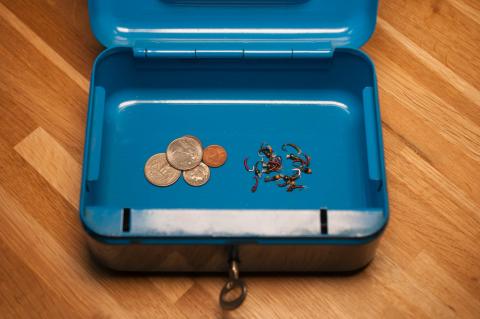realy like this picture
Recent comments
Sarah,
As Martin said the Tail of Salminus maxillosus.
Heiko Schneider, the author of the article
Let us all hope that you will find proper solutions for those problems.
Goodluck,
Best regards from Tom Biesot.
- Log in to post comments
Sarah,
Just as the caption says: The beautiful tail of a dorado
Martin
This is the tail of a Dorado?! Please contact me at sgilbertfox@fisheries.org, if you get a moment. Thank you!
Dear Joseph,
The "poor treatment" is actually a pretty gentle treatment. Brown trout are surprisingly tolerant when it comes to handling. Many of them with a thick leathery skin and a protective layer of mucus, the purpose of which is exactly to protect the fish. This mucus or slime will be regenerated if it's worn off. The whole idea of the leathery, slimy skin of stream fish is protection. They endure some really rough treatment during flooding, when passing rapids and when moving between rocks and branched in the water.
Of course you shouldn't rub the fish around in the grass or place it in gravel or rubble, but landing it gently by hand and laying in the soft grass for a photo is hardly any tougher on the fish than netting it.
These fish are all back in the water within a minute and oftentimes much less, and I doubt they be worse off than if they were just lifted out of a net for a photo and then released.
Some fish are much more vulnerable like loose scaled sea run or saltwater fish. Loosing the scales can be a severe problem, because they take time to grow out again and won't grow if the tissue below is damaged.
Martin
- Log in to post comments
If it is only catch and release, then why the poor treatment of the fish by laying him on the grass? That does some serious damage to his protective slime.
- Log in to post comments
- Log in to post comments
I am very interested i'n getting a look at these DVDs i'n English
- Log in to post comments
This is the best description of buzzer (midge) fishing I have seen. The long leader method is deadly with other midge imitations as well
- Log in to post comments
Jan,
Yes, I am the author... and the designer, publisher, photographer, proof reader and any other role you can think of.
The new book sits on my computer and is about 80-90% done. It's been quite a lot of work to get it ready, and I'm still adding patterns, although I'm running out of patterns that I actually use or have used, and that's the whole idea. The book will cover my own and my nearest fishing friend's favorite flies for sea trout.
My guess is that it will be another month or so before it's available on Blurb. I will annonce it here just like the other GFF books.
Martin
PS: It's now published: Favorite Flies for Baltic Seatrout
- Log in to post comments
Hej Martin,
thanks for your description of this "old" one and your variations about it! You mentioned a new book "Favorite Flies for Baltic Sea Trout". When and where will it be published and are you the author?
Best regards
Jan
- Log in to post comments
Hi. Is there a Video to buy about kvarken Pike fishing??
- Log in to post comments
Dave,
Click on the picture or any link back to the article and read it. That gives away the secret...
Martin
what do you use for body?
GREETINGS, MR. MARTIN JOERGENSEN; I AM NOT YELLING, I USE CAPS.'CUZ IT IS EASIER.THANKS.
WHERE CAN I BUY THE BUBBLES? I USED TO BUY THEM AT WAL=MART BUT CAN'T FIND 'EM ANYMORE.
THANKS.
- Log in to post comments
Nicolas Pariset, you just got pwned by the creator. HAHA.
I waited a long time to watch this DVD. I don't know why I waited so long, it's incredible to say the least.
- Log in to post comments
I used this method last weekend to help out some kids who were having no luck with spinners in the middle of a furious Hendrickson hatch. I found the bubble floats to be a pain. In the end, I just tied 6 feet of 6X tippet to the hook on a bobber, and then tied their mono to the same spot. A generic Elk Hair Caddis had them out fishing me in minutes. The current in the spring creek was strong, and the bobber was giving them a much more consistent drift than my fly line dragging the fly downstream as I constantly mended line. If you don't have to cast more than 20 or 30 feet at a time, I think the simple bobber approach is more than enough, and much easier.
- Log in to post comments
I like the look of this streamer, I'll tie a few and see how they look.
If I come up with any interesting variations, I'll post them on the Forum.
- Log in to post comments
Rick,
My guess is that buzzer fishing would work in your streams too. I'd think that slower parts of the streams with softer bottom would be good candidates for buzzer fishing - parts that could be home to midges and mosquitoes and their larvae, which is what buzzers are imitating.
I usually use a loop knot for small flies like buzzers to enable the fly to move freely. My personal favorite loop knot is the surgeons loop, but other loops work just as fine.
Martin
- Log in to post comments
Hi Martin,
Always enjoy your articles ! I live in the US and fish small streams for trout. Would buzzer fishing be applicable to this type of trout fishing? Also, what type of knot are you using on your beginners buzzer and do you use this knot with most flies that you fish? I know it is to allow more natural movement to the fly..
Thanks Very Much for your articles
- Log in to post comments

